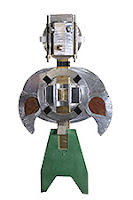Between June 28 and July 27 of 2022, Greg
drove a rented white Toyota Camry from Tucson, Arizona, to Youngstown, Ohio,
and back to Tucson again. I sat beside him, doing a little bit of navigating
using an atlas and maps we picked up in roadside rest stops; we didn’t use GPS,
though each evening Greg did a lot of internet research about the next day’s
routes and destinations. Here is an ekphrastic accounting of the trip featuring one of five art works we saw along the way:
Atomic Thunderbird by Tony Price
On the first day of our trip, after we’d crossed the New Mexico state line and were on our way to our motel room in Socorro, I looked at the atlas in my lap and realized how close we would be staying to the site of the first atomic blast in Alamogordo. I felt a sense of panic for a few intense minutes, and I wanted to say that I wouldn’t stay there, that I needed to go someplace else where the traumatic energy of that 1945 event wasn’t still haunting the terrain. Was it safe, either physically or psychologically, even all these years later?
As we drove toward Socorro, I was in a state of
nuclear anxiety both in relation to place -- because we were so near to ground
zero of the first atomic blast – and in relation to time – because we are in
the middle of the worst U.S.-Russian relations since the Cuban Missile Crisis. My
anxiety, often just below the surface of conscious awareness like a hot
radioactive mist, derives from the fact that the Russians have nukes and so do
we, and American leaders seem almost to be trying to provoke a catastrophic
outcome during the war in Ukraine, and more recently in regard to Taiwan.
That’s why, on the trip home, when we saw the
sculpture called Atomic Thunderbird by Tony Price at the Albuquerque
Museum, again on our way to stay in Socorro on the last night of the trip, I
was so intensely affected by it. I was impressed by Price’s dedication to his
art, to what he consciously thought of as beating swords into plowshares. I
found it moving and immediately thought of him as a kindred spirit.
Self-styled Atomic Artist Tony Price was only eight years old when the first atomic bomb was set off near Alamogordo. He was living in New York at the time, but he was later deeply affected by the event. After he moved to New Mexico in the 1960s, he began to visit the salvage yard at the Los Alamos National Laboratories, where he mined the glass and metal pieces he found there and turned them into sculptures like Atomic Thunderbird. He began to focus his life as an artist on what he called "our nuclear nightmare."
 Trinity Site obelisk. The black plaque on top reads: Trinity Site Where The World's First Nuclear Device Was Exploded On July 16, 1945. This file is licensed under the Creative Commons Attribution-Share Alike 2.0 Generic license. Source: Samat Jain - Flickr: Trinity Site Obelisk National Historic Landmark |
Atomic Thunderbird, made of salvaged stainless steel, bronze, plastic, and fiberglass, radiates a good-natured strength, seemingly unaware of its toxic lineage. Its round head, eyes, and torso give it a biomorphic quality. The title implies that it has some relationship to American Indian mythological birdlike entities of the same name that symbolize power and strength, and thunderbirds from many American Indian belief systems have the power of the storm at their command. In its squat build it resembles some thunderbird depictions that I see online, but Price’s thunderbird reference is more a matter of resonance than cultural appropriation. The Atomic Thunderbird has no feathers, though maybe those curved shapes on either side of its body are wings. Its tail is like the tail of a rocket, its center implies no heart but only a machine’s cold workings, its color is a silver cleansed of traces of life. So Thunderbird yes, in the sense of an entity that’s powerful, and no, in the sense of an organism that could save humans from anything, particularly themselves.
I recently learned that some of Price’s Atomic Art sculptures are on display at Biosphere 2 in Oracle, AZ, which means his kindred-spirit approach to nuclear anxiety is still available to me, now that I’m home.




No comments:
Post a Comment